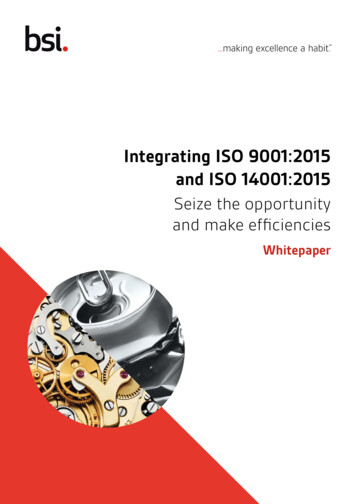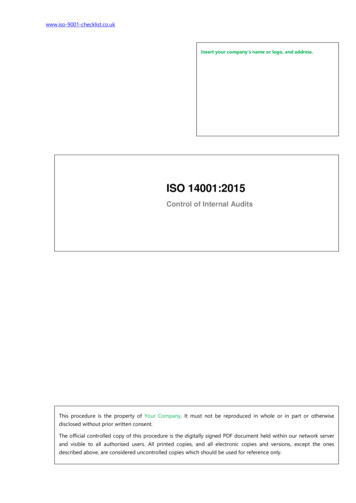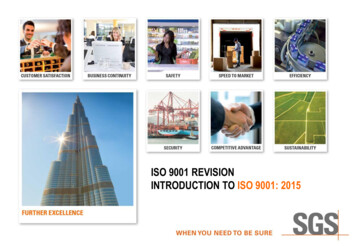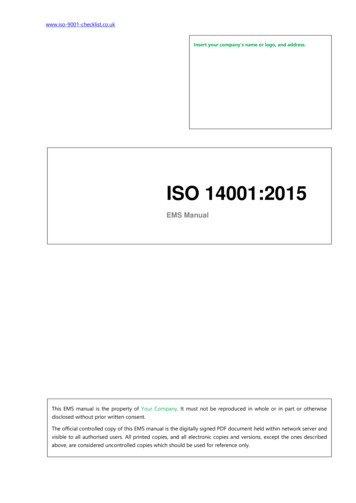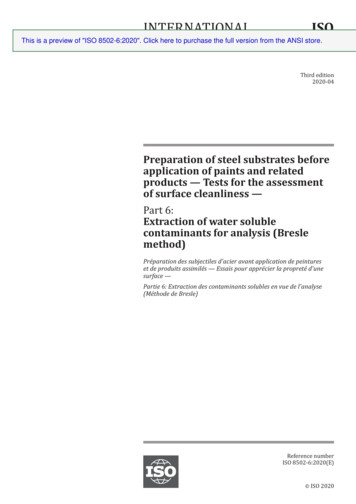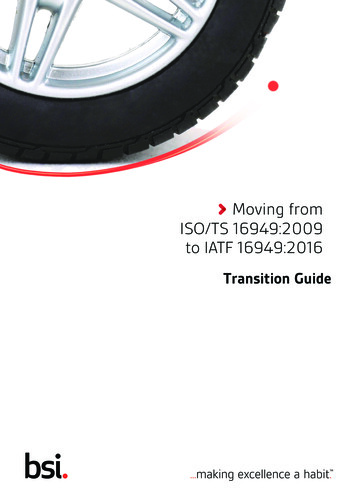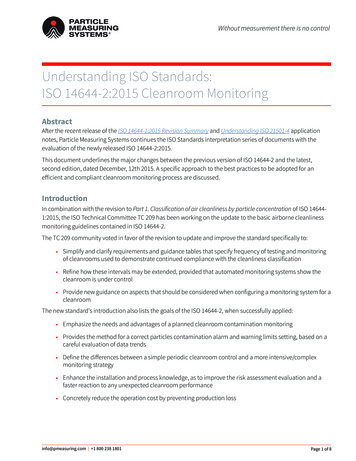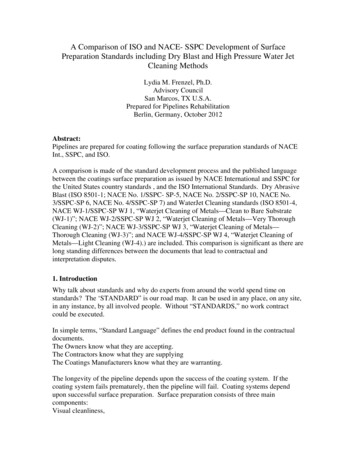
Transcription
A Comparison of ISO and NACE- SSPC Development of SurfacePreparation Standards including Dry Blast and High Pressure Water JetCleaning MethodsLydia M. Frenzel, Ph.D.Advisory CouncilSan Marcos, TX U.S.A.Prepared for Pipelines RehabilitationBerlin, Germany, October 2012Abstract:Pipelines are prepared for coating following the surface preparation standards of NACEInt., SSPC, and ISO.A comparison is made of the standard development process and the published languagebetween the coatings surface preparation as issued by NACE International and SSPC forthe United States country standards , and the ISO International Standards. Dry AbrasiveBlast (ISO 8501-1; NACE No. 1/SSPC- SP-5, NACE No. 2/SSPC-SP 10, NACE No.3/SSPC-SP 6, NACE No. 4/SSPC-SP 7) and WaterJet Cleaning standards (ISO 8501-4,NACE WJ-1/SSPC-SP WJ 1, “Waterjet Cleaning of Metals—Clean to Bare Substrate(WJ-1)”; NACE WJ-2/SSPC-SP WJ 2, “Waterjet Cleaning of Metals—Very ThoroughCleaning (WJ-2)”; NACE WJ-3/SSPC-SP WJ 3, “Waterjet Cleaning of Metals—Thorough Cleaning (WJ-3)”; and NACE WJ-4/SSPC-SP WJ 4, “Waterjet Cleaning ofMetals—Light Cleaning (WJ-4).) are included. This comparison is significant as there arelong standing differences between the documents that lead to contractual andinterpretation disputes.1. IntroductionWhy talk about standards and why do experts from around the world spend time onstandards? The ‘STANDARD” is our road map. It can be used in any place, on any site,in any instance, by all involved people. Without “STANDARDS,” no work contractcould be executed.In simple terms, “Standard Language” defines the end product found in the contractualdocuments.The Owners know what they are accepting.The Contractors know what they are supplyingThe Coatings Manufacturers know what they are warranting.The longevity of the pipeline depends upon the success of the coating system. If thecoating system fails prematurely, then the pipeline will fail. Coating systems dependupon successful surface preparation. Surface preparation consists of three maincomponents:Visual cleanliness,
Profile, or anchor pattern, or roughness,And invisible contaminants such as salt, oil, grease, or chemicals.On a global scale, ISO ( International Organization for Standardization, GenevaSwitzerland) is the primary source for standards for many activities, not just paint andcoatings. ISO membership is comprised of various national standard organizations.ANSI. (American National Standards Institute, New York, USA) is the administrator andcoordinator of the United States private sector voluntary standardization system. ANSI isthe USA member to ISO.Within the USA, various private sector organizations contract with ANSI to provide theexpertise for specific projects. NACE Int. (National Association of Corrosion Engineers,Houston, Texas USA) has contracted with ANSI to provide the technical expertise forCoatings and Surface Preparation issues to ISO. ASTM (American Society for Testingand Materials, West Conshohocken, Pennsylvania, USA) develops and deliversinternational voluntary consensus standards in 135 countries. ASTM contracts with ANSIto provide technical expertise in testing methods to ISO.NACE and SSPC (Society of Protective Coatings, Pittsburgh, Pennsylvania USA)cooperate and jointly develop standards for surface preparation for all types of metals andconcrete. The standards in this paper have joint NACE and SSPC designations.This paper focuses on the dry abrasive blast cleaning and the water jet cleaning standardsof ISO and NACE. NACE has established CIP (Certified Inspector Programs) toprovide inspectors trained and tested to NACE standards all over the world. The NACECIP started 28 years ago and has provided over 19,000 certified inspectors globally.NACE CIP is the world’s most recognized coating inspector certification program.Inspectors trained and certified to NACE or inspectors trained and certified to ISOstandards will likely have different interpretations.2. Standards DevelopmentBoth ISO and NACE have a hierarchy for development, with checks and balances.Because NACE submits their comments through ANSI who then submits the commentsto ISO, the USA, or country, standard process for development must conform to bothANSI and ISO requirements.Typically the participating countries for coatings include: Sweden, Germany, UnitedKingdom (BSI), Netherlands (NEN), United States (NACE), Japan, France (AFNOR),Finland, Belgium, Portugal, South Africa, Korea, and Australia. There are certainly manymore countries who might be involved, but discussions, in my experience, arise betweenGermany, Sweden, Norway, United Kingdom, Netherlands, Japan, Sweden, and theUnited States delegates.At ISO,
First a country must submit a new work item proposal (NWI) to the appropriateTechnical Committee (TC 35). If it is accepted, and if a minimum of countries agree to participate, then a taskgroup is formed. During this response, the country who proposed the worktypically provides a chair and author to write the document. A committee draft (CD) is prepared by the author who is normally the chair of theWorking Group (WG) under a specific SubCommittee (SC). The committee draft (CD) is circulated for comments. The chair-author of the Working Group (WG) resolves the comments. This cycle is repeated, until a Final Draft International Standard (FDIS) is issuedfor review and comment.Each country has one vote. You can make comments, but once the FDIS is sent, thecomments are set aside until the next review period.Similarly, at NACE Someone proposes a new standard or guide. This new proposal is circulated to the Specific Technology (ST) group that will bethe sponsor. If it is accepted, then a Task Group (TG) is formed, and a chair, whois generally the person who proposed the work and will be the author, is selected. The Task Group (TG) Chair produces a draft, and it is circulated for comments,typically not a “ballot.” The draft is also circulated to the Recommended Practices Committee Chair(RPC) who is responsible to see that the proper format is followed. The draft continues to evolve through comment and ballot cycles until all thecomments are addressed, and, in the case of technical negatives, are resolvedthrough written communication.In the case of cooperative standards that are joint between NACE and SSPC, there is ajoint task group consisting of senior members from both societies to resolve differences.What is different between NACE and ISO? NACE has several opportunities for face-toface meetings, extended email, and informal discussion to resolve differences. We reachconsensus by dynamic discussion and resolved all technical negatives in writing.ISO handles all communication by email/mail written documentation as they originatefrom country organizations. The face-to-face meetings are infrequent. The chaircompiles the comments and sends out his resolution. By the time the country, ie NACE,gets the comments, the time to build consensus between the participating countries isover.At ISO, the country experts that are submitting comments are remote or isolated from thechair of the task group, or author of the documents. At NACE, the chair/author isworking continually to accept editorial modifications.At ISO, once a level of review is reached, you cannot go back.
As an example, in reviewing the chair comments that are sent out after a ballot, we, theNACE Technical Advisory Group (TAG) often agree that BSI-United Kingdom sawsomething that we missed, but the chair/author has already ruled on their comment. If thechair/author doesn’t agree with the comment, it isn’t accepted. The interaction of thecountry delegates between one another to say “Do you see the same thing that someoneelse sees?” is missing.As a recent example, the USA had voted negatively on a Committee Draft for profilemeasurement with specific technical comments and suggested language. At that level, thedocument couldn’t proceed to a Final Draft International Standard (FDIS). About 6months later, at a meeting in Europe, the USA head of delegation had an ad-hoc meetingwith the author/chair. At that as hoc meeting, the chair accepted the technical arguments,and was to amend the Draft to include the changes. The exact words proffered by theUSA were not necessarily adopted at the ad hoc meeting so much as the chair agreed inprincipal to accept the argument. On the basis of this understanding, the USA withdrewits negative, and agreed to proceed to FDIS. The formal minutes of the Working Groupmeeting denote that the draft would move to FDIS.However, when the FDIS came out for final ballot some months later, only part of thetechnical comments had been included in the new draft. In the ISO system, the chair doesnot typically offer the intermediate drafted document to the specific countries that hadproffered comments. The rest of the countries have no way of knowing that the agreedchanges were not included.The USA reluctantly voted negative on the FDIS with the same comments that had beenproffered earlier. Our items of concern remained in the Standard. The FDIS didn’t changein wording, and it will be likely 5 years before it is reviewed again.In the USA NACE system, a technical negative must be clearly resolved by the chair inwriting. In addition, there are two other review and over-sight levels that can suggestchanges. Any negative technical comments that are not resolved must accompany theballot before final acceptance within the Society up to the Board of Governors orStandard Review Committee.The process within ISO and NACE are similar, as for all the countries that participate inISO procedures. The ISO consensus process is, in my opinion, more remote. I haveobserved very valid comments by my German, British, and Dutch colleagues apparentlygo unanswered.3. Standard ListISO sets up a list of anticipated standards and numbers them sequentially. NACE, alongwith SSPC, has standards which are numbered as they were developed.Technical Committee ISO/TC 35, is responsible for Paints and varnishes, TheSubcommittee SC 12 is responsible for Preparation of steel substrates before applicationof paints and related products. SC12 has issued four documents. ISO 8501 consisting of
the following parts, under the general title Preparation of steel substrates beforeapplication of paints and related products —Visual assessment of surface cleanliness:8501-1 Part 1: Rust grades and preparation grades of uncoated steel substrates and ofsteel substrates after overall removal of previous coatings8501-2 Part 2: Preparation grades of previously coated steel substrates after localizedremoval of previous coatings8501-3 Part 3: Preparation grades of welds, cut edges and other areas withsurface imperfections8501-4 Part 4:Preparation grades of coated and uncoated steel substrates after removal ofrust and previous coatings by high pressure water jettingISO TC 35/ SC12 has issued 13 documents under ISO 8502 Preparation of steelsubstrates before application of paints and related products —Tests for the assessment ofsurface cleanliness. These standards include field and laboratory tests, extraction,chloride, oil and grease, water-soluble salts, conductometric methods, the Bresle Method,and rigid conductivity meters.ISO 8503 covers Surface roughness characteristics of blast-cleaned steel substrates;ISO 4628 covers Evaluation of degradation of paint coatings.ISO 8501-1 originated as a series of photographs that includes scraping and wirebrushing, as well as abrasive blast cleaning.The NACE Recommended Practices are:Joint Surface Preparation Standard NACE No. 1/SSPC-SP 5 White Metal Blast Cleaning NACE No. 2/SSPC-SP 10 Near-White Metal Blast Cleaning NACE No. 3/SSPC-SP 6 Commercial Blast Cleaning NACE No. 4/SSPC-SP 7 Brush-Off Blast Cleaning NACE No. 8/SSPC-SP 14 Industrial Blast CleaningTraces of tightly adherent mill scale, rust, and coating residues are permitted to remain on10 percent of each unit area of the surface in NACE No. 8.SSPC-SP 2 Hand Tool CleaningSSPC- SP3 Power Tool CleaningSSPC –SP 11 Power Tool Cleaning to Bare MetalThe above documents provide the written standards or Recommended Practices. Thevisual photographs are in SSPC VIS-1 Visual Standard for Abrasive Blast Cleaned Steel(Standard Reference Photographs) and SSPC- VIS 3 “Visual Standard for Power- andHand-Tool Cleaned Steel (Standard Reference Photographs).ISO 8501-4 is a combination of visual reference photographs originally produced byInternational Paint and Hempel Marine Coatings, and text that is similar to 8501-1.The NACE Recommended Practices, published in 2012, are:Joint Surface Preparation Standard
Waterjet Cleaning of Metals—Clean to Bare Substrate (WJ-1)Waterjet Cleaning of Metals—Very Thorough Cleaning (WJ-2)Waterjet Cleaning of Metals—Thorough Cleaning (WJ-3)Waterjet Cleaning of Metals—Light Cleaning (WJ-4)The Reference photographs are in NACE VIS 7/SSPC-VIS 4, Guide and VisualReference Photographs for Steel Cleaned by WaterjettingVisible Cleanliness Preparation GradesAnalogous between NACE and ISOCleaning Grade(abrasive)NACE, SSPCWhite metalNear-WhiteCommercialIndustrialBrush OffCleaning Grade(water alone)ISO, NACEBare metalVery ThoroughThoroughThoroughLightNACEabrasiveNACE SSPCSSPC abrasiveISOAbrasive Water12384WJ-1WJ-2WJ-3WJ-3WJ-4Sa 3Sa 2 ½ Wa 2 1/2Sa 2Wa 2SP-5SP-10SP-6SP-14SP-7Sa 1Wa 13. Comparison of Blast Cleaning by Abrasive and Cleaning by Water JettingISO originally published its standard for dry blast cleanliness in collaboration with theStadardiseringskommissionen/Sverige (SIS, Stockholm Sweden) with “Pictorial SurfacePreparation Standard for Painting Steel Surfaces” as a set of photographs, with very littletext. The photograph is the primary standard.This emphasis on photographs, along with the adoption of language that described dryabrasive blast cleaned surfaces, is continuing to lead to confusion between practicesbased on ISO 8501-1 or 8501-4 and the SSPC- NACE Versions. SSPC (Pi
3/SSPC-SP 6, NACE No. 4/SSPC-SP 7) and WaterJet Cleaning standards (ISO 8501-4, . visual photographs are in SSPC VIS-1 Visual Standard for Abrasive Blast Cleaned Steel . NACE, SSPC ISO, NACE NACE NACE SSPC SSPC ISO . Standards. International Organization for Standardization (ISO) Preparation Standards including Dry Blast and High Pressure Water Jet Cleaning Methods Lydia M.

